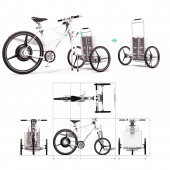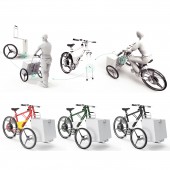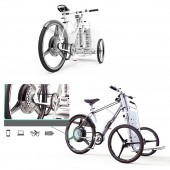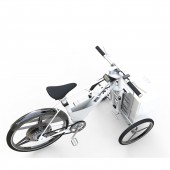
| THE AWARD |
| CATEGORIES |
| REGISTRATION |
| SUBMIT YOUR WORK |
| ENTRY INSTRUCTIONS |
| TERMS & CONDITIONS |
| PUBLICATIONS |
| DATES & FEES |
| METHODOLOGY |
| CONTACT |
| WINNERS |
| PRESS ROOM |
| GET INVOLVED |
| DESIGN PRIZE |
| DESIGN STORE |
| THE AWARD | JURY | CATEGORIES | REGISTRATION | PRESS | WINNERS | PUBLICATIONS | ENTRY INSTRUCTIONS |
Cargob Urban Eco-Bicycle Two in One Eco-Bike by Peng Zhan |
Home > Winners > Design #48244 >Interview |
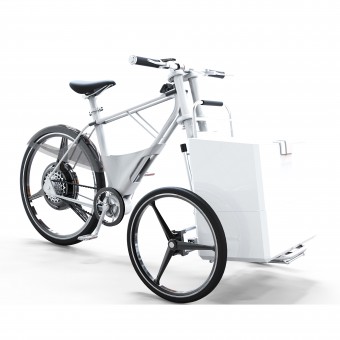 |
|
FS: What is the main principle, idea and inspiration behind your design?
PZ: It’s a global trend that more people will be riding bicycle in urban area, as the urban areas are becoming more saturated leaving less room for vehicles and a greater need for cycling. It’s also a global trend that clean and recyclable energy will be more commonly needed and utilized. This idea is to merge the two trends together and build something to relieve the traffic problem and at the same time promotes cleaner energy and faster delivery experience.
FS: What has been your main focus in designing this work? Especially what did you want to achieve?
PZ: This design is aiming to provide a more environment and space friendly solution to delivery businesses. I wanted to use this design to make bicycle delivery more popular and easier for the delivery people. Currently most consumer goods are delivered from the point of production through one or more points of storage to a point of sale. Same happens to personal deliveries. Packages are tossed through various points or storage before they arrive in their destination. Usually the bicycle delivery will happen in the last point of destination and most likely in the most crowed city center area. With the improved delivery bicycle design, the delivery people will be able to separate the front cart from the bike, so that every time time the deliver guy arrives at ta building, instead of unloading all the packages into another cart, he can simply unlock the front cart from the body of the bike and pull it into the building. What’s more, the motor on the back wheel can collect energy from riding and breaking. Subsequently, they can transfer the kinetic energy into electronic energy to charge other devices such as phones or the LED light on the bike. Last but not least, the user experience aims to simplify the delivery process. Deliverers can use the app to navigate their route once the addresses on packages are scanned into the system. Meanwhile, messages will be automatically sent to recipients to inform them of the delivery time. after receiving the package, recipients can also sign on the app to save the manual process of typing information into the postal system from the backend. At last, the app can also be used to reschedule undelivered packages.
FS: What are your future plans for this award winning design?
PZ: As a product designer, my vision and personal goal is to design good product to simplify people’s lives. Winning the A’ Design Award strengthened my belief in this vision and that my dream will come true someday in the future will all my hard work. With this project, I hope someday, a big brand company with more influence and power can adopt the idea and make the concept true.
FS: How long did it take you to design this particular concept?
PZ: It was my thesis project when I was in CCS (College for Creative Studies) in United States. This whole project took me one year including design research, filed research, design concept, mechanical Design, prototype model making and so on.
FS: Why did you design this particular concept? Was this design commissioned or did you decide to pursuit an inspiration?
PZ: Initially, I wanted to design something to relieve the traffic problem and at the same time promote cleaner energy. Green mobility transportation is the most efficient way in urban environment. Because it is global trend that more and more people want to make living environment better.
FS: Is your design being produced or used by another company, or do you plan to sell or lease the production rights or do you intent to produce your work yourself?
PZ: No, my design is not being produced or used by another company. And yeah, I am really glad to co-work with some companies who can help me make this concept become real product. I will be really happy if my design can someday serve more people and make more people live a more convenient life. It is also my passion and mission that is design good products that can simplify people’s life.
FS: What made you design this particular type of work?
PZ: Initially, I wanted to design something to relieve the traffic problem and at the same time promote cleaner energy. Green mobility transportation is the most efficient way in urban environment. And it is global trend that more and more people want to make living environment better.
FS: Where there any other designs and/or designers that helped the influence the design of your work?
PZ: No, it was only me. However, when I was working on the mechanical part of the design, I visited the Detroit bike company, and asked their engineers to help me figure out how to make my design structure work.
FS: Who is the target customer for his design?
PZ: This project’s target customer is delivery companies or chain store including restaurant, supermarket, magazines and newspaper companies. Beyond that, the target customer can also be every single person. People can use it in their life, wherever the bike can help with simplifying their lives.
FS: What sets this design apart from other similar or resembling concepts?
PZ: The most unique features of the design are that firstly the front cart can be separated from the bike and pulled as a normal cart, secondly the motor on the back wheel can collect energy from riding and breaking. Subsequently, they can transfer the kinetic energy into electronic energy to charge other devices such as phones or the LED light on the bike. For this particular feature, I was inspired from the electronic bicycle designed by Smart. The bicycle I designed has the same technology featuring the rear wheel that has a smart motor inside which can collect the riding energy.
FS: How did you come up with the name for this design? What does it mean?
PZ: My design name called “Cargob”. It have two different means. Firstly it means Cargo bike, “B” means bike, so combining those two words becomes Cargob. Another interpretation is “Car” goes to “Bike”. This name represents my hope that people will ride more bicycles instead of cars in the future.
FS: Which design tools did you use when you were working on this project?
PZ: I used a 3d software called “Rhino” to build the model, and a rendering software called “Keyshot” to add and demonstrate the materials and color. Also I also used adobe illustrator to do some graphic work. Those software can help me to show my idea.
FS: What is the most unique aspect of your design?
PZ: From the whole view of this design, the exterior looks very new, modern and refreshing. The whole structure is very simple and easy to manufacture. From the function perspective, firstly, the front cart can be separated from the bike, so that every time the deliver guy arrives at a building, instead of unloading all the packages into another cart, he can simply unlock the front cart from the body of the bike and pull it into the building. Secondly, the motor on the back wheel can collect energy from riding and breaking. Subsequently, they can transfer the kinetic energy into electronic energy to charge other devices such as phones or the LED light on the bike. All of those design elements together makes the design unique.
FS: Who did you collaborate with for this design? Did you work with people with technical / specialized skills?
PZ: It was only me. However, when I was working on the mechanical part of the design, I visited the Detroit bike company, and asked their engineers to help me figure out how to make my design structure work.
FS: What is the role of technology in this particular design?
PZ: Firstly, the front cart can be separated from the bike, so that every time the deliver guy arrives at a building, instead of unloading all the packages into another cart, he can simply unlock the front cart from the body of the bike and pull it into the building. Secondly, the motor on the back wheel can collect energy from riding and breaking. Subsequently, they can transfer the kinetic energy into electronic energy to charge other devices such as phones or the LED light on the bike. For this particular feature, I was inspired from the electronic bicycle designed by Smart. The bicycle I designed has the same technology featuring the rear wheel that has a smart motor inside which can collect the riding energy. That is a new technology in the field.
FS: Is your design influenced by data or analytical research in any way? What kind of research did you conduct for making this design?
PZ: From the research it was concluded that 51% of freight in Euro-cities could be moved by bike. The data was compiled from 322 European cities in which at least half of freight deliveries could be transferred by bike delivery. Freight moving comprises only about 15 percent of all transportation trips in a city but it makes up 30% of transport's energy consumption. For example, IKEA has one of the most famous bike-based delivery options. From my market research and questionnaire in Chicago and online research, I came to the conclusion that more people are riding bicycles in urban areas. They may ride bikes because it saves time, it saves money, saves parking and moving space, or it helps them to exercise. While after that, I wonder the same benefits of riding bikes would apply on delivery companies too.
FS: What are some of the challenges you faced during the design/realization of your concept?
PZ: The biggest challenge is the limit of weather and location. My design is more practical in urban areas, and also in areas where the weather tends to be more stable (ie. less snow or other extreme weather conditions) What’s more, in the design process, I need to consider the weight and volume of the transported goods. The weight of the transported goods should be defined by the maximum load allowance for bicycles.
FS: How did you decide to submit your design to an international design competition?
PZ: Because my goal is to create good designs which can make more and more people have simplified and convenient lives, and at the same time solve some social problems such as the environmental problems. I hope this design can be exposed to more people and more enterprises through A’ Design Award, which may help with future (possible) production of the design.
FS: What did you learn or how did you improve yourself during the designing of this work?
PZ: I learned that design is a process, is an approach to problem-solving, is a creative process of thinking backwards from people, based on the conclusions of the knowledge gathered in the process. A good design is not simply to create “nice things”, but most importantly is to solve a problem or meet certain needs. A good design is empathy. It shifts the thinking from technology or objects to people. That requires a lot of prerequisite research work and gaining knowledges from different areas, including engineering. A good design can improve people’s lives, and at the same time, maintain an elegant and eyeball catching appearance and beauty that would bring people a pleasant experience as well.
FS: Any other things you would like to cover that have not been covered in these questions?
PZ: No, thanks.
FS: Thank you for providing us with this opportunity to interview you.
A' Design Award and Competitions grants rights to press members and bloggers to use parts of this interview. This interview is provided as it is; DesignPRWire and A' Design Award and Competitions cannot be held responsible for the answers given by participating designers.
| SOCIAL |
| + Add to Likes / Favorites | Send to My Email | Comment | View Press-Release |
